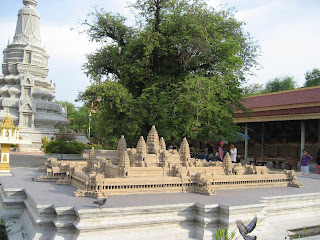 Before I get to Siem Reap, I have one more digression to get through--traffic. The photo to the left was taken outside of my guest house in Phnom Penh. Here the scooters ran up and down the street in every direction all day. Crossing this street was no easy feat--and this was a narrow street. When I was in Phuket, I thought there was a ridiculous amount of scooters. That was nothing compared to Phnom Penh and Siem Reap. Not only are there a million scooters on the road, but there are no apparent traffic laws. Not to mention there are cars, trucks, bicycles, and pedestrians in the mix.
Before I get to Siem Reap, I have one more digression to get through--traffic. The photo to the left was taken outside of my guest house in Phnom Penh. Here the scooters ran up and down the street in every direction all day. Crossing this street was no easy feat--and this was a narrow street. When I was in Phuket, I thought there was a ridiculous amount of scooters. That was nothing compared to Phnom Penh and Siem Reap. Not only are there a million scooters on the road, but there are no apparent traffic laws. Not to mention there are cars, trucks, bicycles, and pedestrians in the mix.
To the left we see a family of (count 'em) five on a scooter. This was not at all uncommon to see. I wondered exactly where all of these people were going? These scooters just move along at a slow speed and somehow avoid hitting each other or getting run over. I did what I could to capture pictures from the back of my tuk tuk, but it took too much concentration and I preferred to sit back and enjoy the scenery. It was fun to relax in my seat and watch this total clusterf**k (I've never been one to use profanity in my blog, but this is the only way the traffic can be aptly described.) unwind and intertwine.

Imagine if you had this scenario in a U.S. city. People would be losing their minds and raging all over the place. Here everyone is totally accustomed to this and they just drive slowly and stay out of each others ways. There are no stop lights and the side of the road you should drive on is merely a suggestion. I had a driver go about a half a mile down a busy street driving down the left side of the road into traffic. This was a sight to behold. Oddly, there is an order in this total disorder. Everyone works together and it just works out somehow. They work together by keeping their eyes open and avoiding each other.
 Here's another picture of scooters everywhere. I think the traffic is indicative of their society in that there are no regulations or laws, but somehow through the chaos they find an order that works for them. It's every man for himself, but nobody runs over another person in the process. It's a strange web of cooperation through doing one's own thing while avoiding others doing theirs. It may not be the most orderly society, but it sure is fascinating. I could have ridden around for days and just watched the traffic, but there was too much more to see.
Here's another picture of scooters everywhere. I think the traffic is indicative of their society in that there are no regulations or laws, but somehow through the chaos they find an order that works for them. It's every man for himself, but nobody runs over another person in the process. It's a strange web of cooperation through doing one's own thing while avoiding others doing theirs. It may not be the most orderly society, but it sure is fascinating. I could have ridden around for days and just watched the traffic, but there was too much more to see. Here we see a small family on a scooter and a little youngster looking back towards me. Luckily the kid didn't look directly at me because I would've probably been harassed for money. That week I didn't see a single wreck, but I did have about fifty close calls in the tuk tuk. It's crazy how close the traffic comes to one another. Anyway, on the topic of more to see... I've been going through my Angkor Wat pictures and will begin my journey through Siem Reap in the next entry. There are so many pictures and I'll have to make some difficult choices. However, expect to see some spectacular temples in the upcoming week.
Here we see a small family on a scooter and a little youngster looking back towards me. Luckily the kid didn't look directly at me because I would've probably been harassed for money. That week I didn't see a single wreck, but I did have about fifty close calls in the tuk tuk. It's crazy how close the traffic comes to one another. Anyway, on the topic of more to see... I've been going through my Angkor Wat pictures and will begin my journey through Siem Reap in the next entry. There are so many pictures and I'll have to make some difficult choices. However, expect to see some spectacular temples in the upcoming week.












